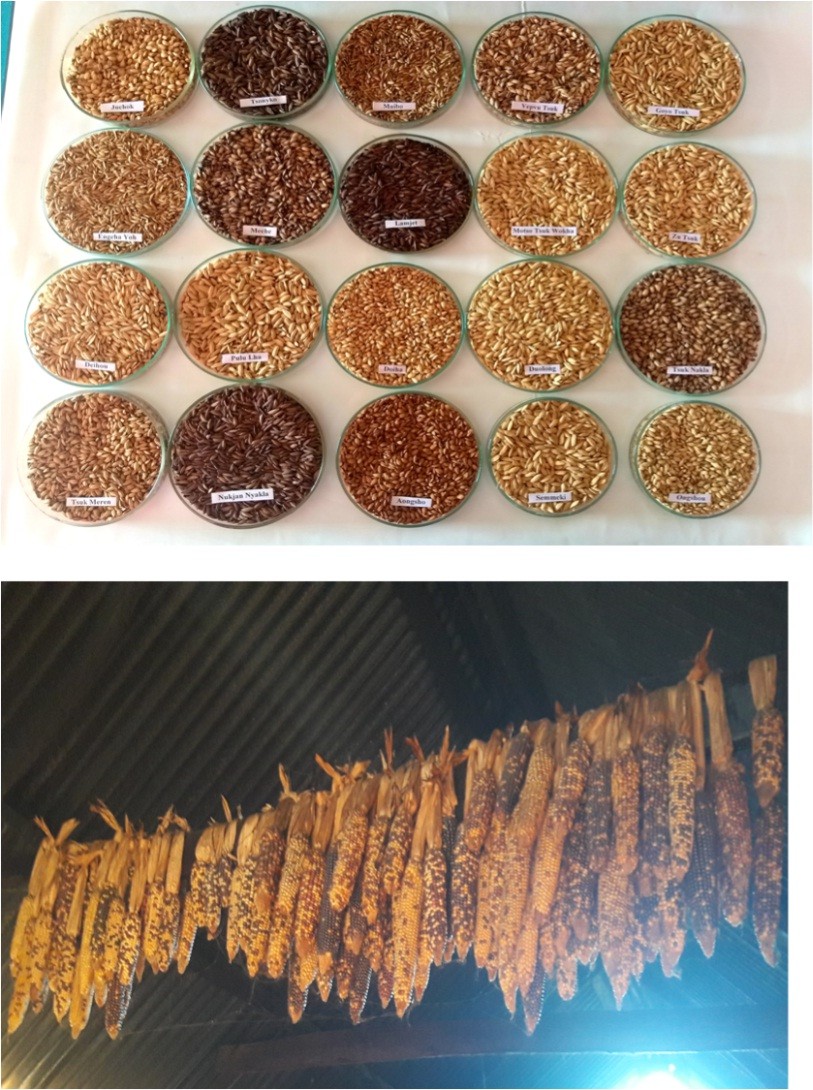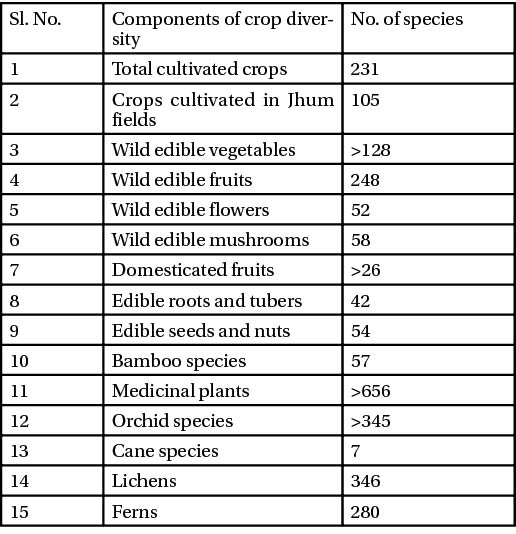Rice and Maize diversity of Nagaland

Harendra Verma, S Theunuo, D J Rajkhowa & B K Kandpal
Nagaland is situated in the North-eastern part of India and has a geographical area of 16,579 sq. km. (6,401 sq. miles). It receives an average annual rainfall between 2000 mm to 2500 mm. Due to the varying physiographical and geo-climatic conditions, the state is gifted with a rich biodiversity comprising of approx. 2,431 species belonging to 963 genera and 186 families. The biological diversity also includes 867 traditional land races of rice which was identified by the State Agriculture Research Station (SARS) (Sharma, 2017). Nagaland documented the world’s tallest paddy, Melhite Kenye Lha (Guinness Book of World Records, London, 1998 to 2005) which is eight and half feet tall, the tallest Rhododendron tree in the world, standing at 108 feet and the world’s hottest pepper, “Naga Mircha” (1,041,427 SHU). Germplasm of wild species of tomato L. pimpinellifolium, has been found in NE region. Tree tomato of Nagaland received GI in April, 2014 (Govt. of India, 2014).
Table 1. Crop diversity found in Nagaland

Source: Department of Environment, Forests & Climate Change, Government of Nagaland
The importance of crop diversity in relation to humans is manifold. The society is fully dependent on crop diversity for food supply, medicine, fuel and other necessities. The traditional landraces conserved by farming community of north east can serve as an important gene pool for valuable traits, for example, the upland landraces of rice present in northeast India are photoperiod drought tolerance, photoperiod insensitivity, disease and insect resistance, better root system etc. (Verma et al., 2019; Umakanth et al., 2017). Crop diversity plays a crucial role in sustaining livelihood of the people. As such, its conservation has become very crucial. However, this rich diversity is declining due to a number of factors such as commercialization of agriculture which leads to genetic erosion of important landraces and decreased genetic diversity. Mono-cropping pattern, cultivation of only few popular HYV of crops use of pesticides and insecticides, slash and burn agriculture, etc. led to deterioration of soil as well destruction of natural habitat and loss of biodiversity. Human intervention is also a major concern. Increase in population, deforestation, construction of buildings further added to the loss of biodiversity. The development of crop and its yield is affected by the adverse effects of climate change (Porter & Semenov, 2005). These include disturbances in pollination, soil diversity, nutrient cycling processes and genetic erosion of local landraces. Floods and prevailing environmental changes also led to increased incidences of pests and diseases, which have indirect impact on endemic species (Newton et al., 2008). As a result, many species in Nagaland are on the verge of extinction.
The need for its conservation thus becomes very critical. At the national forefront, PPV & FR Act, 2001 is working for the conservation of crop diversity. The dwindling of crop diversity brought about by the aforementioned activities led to erosion of genetic resources which forms the basis for food and agriculture. Genetic resources aid in addressing both biotic and abiotic constraints (Lane and Jarvis, 2007). This act encourages the farmers to continue using landraces which forms the key to improvement in crop productivity and fills the conspicuous gap that exists between research, farmers and plant breeders while protecting plant varieties and rights of farmers and plant breeders. It recognizes the contributions made by the farmers in conserving, improving and making available plant genetic resources for developing new varieties to meet the food needs. The period of protection is 15 years for field crops and notified varieties and 18 years for trees and vines. Under this act, novel, extant, farmers’ and essentially derived variety can be registered. Any variety is eligible for registration if it fulfills the norms and criteria of DUS i.e., Distinctiveness (easily distinguishable), Uniformity (similar) and Stability (not changing from one generation to the next). The protection for a variety can be applied by any person claiming to be the breeder or successor of the variety, farmer or group of farmers, university or publicly funded agricultural institution.
Under the PPV & FRA, three groups are identified- breeders, researchers and farmers. Breeders are allowed to produce, sell, distribute, market, import and export the protected variety. Researchers can use any registered variety for conducting experiments. They can also use initial varieties for developing new varieties. Farmers can save, use, sow, re-sow, exchange, share or sell farm produce including seed of the registered variety. Farmers are largely responsible for the extraordinary genetic diversity that exists today. They are entitled to rewards and recognition. Farmers can also registered extant varieties in addition to farmers’ varieties with exemption from payment of fees. PPV & FR Act is the need of the hour. It facilitates the right to participate in benefit-sharing which arises from the utilization of plant genetic resources (PGRs) as well as participate in decision making relating to conservation and sustainable use of PGRs for food and agriculture. The act can also facilitate the growth of the seed industry by ensuring the supply of quality seed to the farmers. It promotes all forms of traditional knowledge related to genetic resources through its protection and constitutes the capping of production of food and agriculture in general throughout the world. Till now only a very few landraces of various crops have been registered under PPV & FRA from Nagaland. This act can bolster the creation and conservation of biological diversity and their wild relatives using insitu as well as exsitu. There is a need to impart knowledge on the varietal diversity of crop species present in Nagaland as well as the importance of PPV & FRA thereby, creating awareness among the local masses which in turn can serve as the foundation for the conservation of genetic resources of plants and their wild relatives and crop diversity as a whole. ICAR Nagaland centre is bolstering the farmers of Nagaland for registration of landraces of various crops under PPV & FRA.
References
1. Dinesh C Sharma Kohima | Updated on January 09, 2018 Published on December 13, 2017
2. Govt. of India, (2014) Geographical Indications Journal No. 61 NOVEMBER 21, 2014 / KARTIKA 30, SAKA 1936.
3. Dept. of environment, forests & climate change, Govt. of Nagaland
4. Verma H, Borah, JL & Sarma RN (2019). Variability assessment for root and drought tolerance traits and genetic diversity analysis of rice germplasm using SSR markers. Sci Reports, 9: 16513.https://doi.org/10.1038/s41598-019-52884-1
5. Umakanth B, Vishalakshi B. et al., (2017). Diverse rice landraces of north-east India enables the identification of novel genetic resources for Magnaportheresistance. Front. Plant Sci, 8: 1500.
6. Porter, J. R. and Semenov, M. A. (2005). Crop Response to Climatic Variation. Philosophical transactions of the Royal Society Biological Sciences, 360 (1463): 2021-35.
7. Newton, P., Thai, N. V., Roberton, S. and Bell, D. (2008). Pangolins in peril: using local hunters’ knowledge to conserve elusive species in Vietnam. Endang Species Res. 6:41-53.
8. Lane, A. and Jarvis, A. (2007). Changes in climate will modify the geography of crop suitability: agricultural biodiversity can help with adaptation. SAT e-Journal. 4(1): 1-12.




